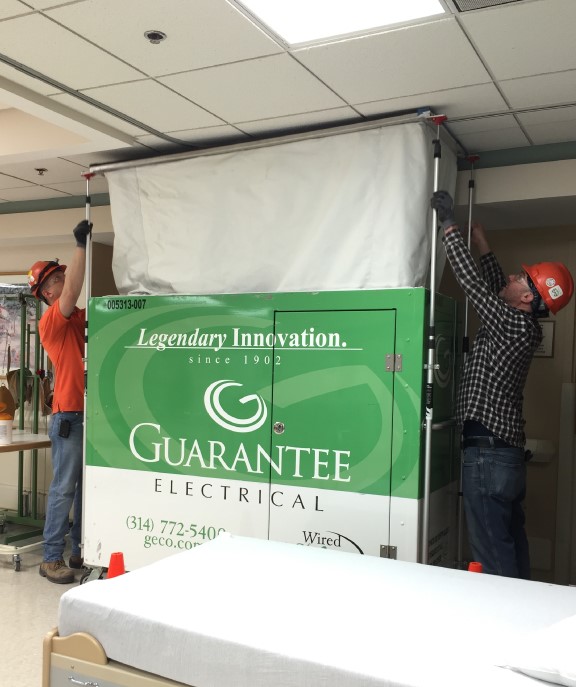Among the many factors involved with supplying construction services to acute care hospitals is meeting the higher levels of patient safety and sanitation that have emerged in the wake of the Affordable Care Act. Over the last decade alone, building automation  with its sophisticated electrical and mechanical systems devoted to environmental controls managing air flow and quality, temperature and humidity has expanded exponentially. Moreover, as evidence-based analytics tracking care delivery have become more wide spread and more exacting, dozens previously un-regarded environmental factors now have to be monitored and controlled for assuring sanitation and infection control as well as security.
with its sophisticated electrical and mechanical systems devoted to environmental controls managing air flow and quality, temperature and humidity has expanded exponentially. Moreover, as evidence-based analytics tracking care delivery have become more wide spread and more exacting, dozens previously un-regarded environmental factors now have to be monitored and controlled for assuring sanitation and infection control as well as security.
The more institutions dig in to the data, the more they discover about avoiding exposure to patient harm. As recently as 2013, the Agency for Healthcare Research and Quality noted that one in every eight hospital admissions involved some form of patient injury.* As quantitative, evidence-based medicine have become central to clinical practice and environmental control, factors affecting safety at all levels have been made a priority with respect to standard practices, with expanded scrutiny of every environmental variable that can be monitored and managed.
When construction takes place within healthcare facilities, another whole set of variables—for good or bad—emerge. Not least, is the fact that acute care institutions engage in around-the-clock patient care; and this places an extra burden on construction teams as they seek to minimize the impact of their work on the patient care environment, even as they as they manage costs for their hospital customers.
In facilities under construction, patient safety depends on reducing the impacts of construction processes on the treatment care environment. With renovation-expansion projects in particular, achieving this objective requires continuous information exchange between all members of the construction team and just as importantly with facility management. These factors contribute significantly to better and easier knowledge sharing and coordinated team activity, assuring smooth exchanges of data vital to protecting the care-giving environment.
Preconstruction planning, prefabrication and judicious scheduling help to minimize construction activity in or adjacent to the patient care setting while reducing or preventing a variety of hazards, from noise to dust and mold released by vibration in floors and walls that can disturb contaminates in ceilings and other previously sequestered areas. In most cases, careful planning and good communications with the facility’s management team can enable construction personnel to optimally align their activities with care-giving operations.
Coordinated scheduling, for example, can identify optimal times of day for optimal staging of activities potentially invasive activities, while still enabling workers to proceed on schedule. Often this involves shift work on the part of the construction teams, with limited “windows” of time established for demolition and drilling (sometimes requiring mere minutes at a time for tasks involving noise)—and then applying the quietest low impact tools and methods available. Under such circumstances, craftsmanship is at a premium, with tasks assigned to veteran crews with the experience and training to assure that vital tasks get accomplished successfully within the allotted windows of time.
In addition to accurate and efficient installations managed through coordinated schedules, construction tasks themselves may have to be conducted within hospital cleanliness standards required for infection control and patient safety. In recent years, great strides have been made in debris-containment technologies. For renovation projects involving demolition and drilling operations in especially sensitive patient care spaces construction teams will use a portable sanitary mini-work environment that forms an encapsulating seal against accidental release of dust and debris associated with processes like drilling or demolition into the patient care space.
Combining negative air pressure fans with true HEPA (High Efficiency Particulate Arresting) filtration systems, these highly portable anterooms or HEPA carts are designed to fit through standard institutional doors, are mounted on wheels and use adjustable, sealable screens that reach ceiling heights to isolate the work area. The carts are capable of containing and filtering 99.7 percent of airborne debris, in the form of dust, fumes and mold, and a host of other potentially hazardous particulates harbored in ceiling space that might otherwise be released into the air outside the containment area.
Over all, contractors with deep experience in hospital construction understand how to outfit their crews with technologies they need to assure infection control combine with effective constructability analysis, 3-D modeling and GPS based Trimble® devices to deliver a safe and efficient construction process. Trimble in particular provides project managers with ways to map “smarter” installation strategies for “lowest impact” construction in or near patient care spaces.
Preconstruction planning is among the most effective strategies for assuring low impact and patient-safe construction deliverables; it’s also increasingly indispensable to successful collaborative planning and execution of work by interdisciplinary teams. Among a range of valuable outcomes are the reduction or elimination of costly clashes and schedule conflicts that could prolong processes, adding to the potential to impinge on patient care and the safety of everyone in the project area.
*Bob Kehoe, Health Facilities Management magazine, December 2015, “Front Lines of Patient Safety.”